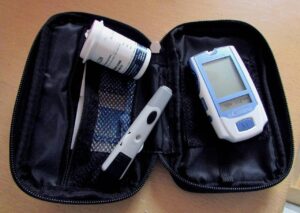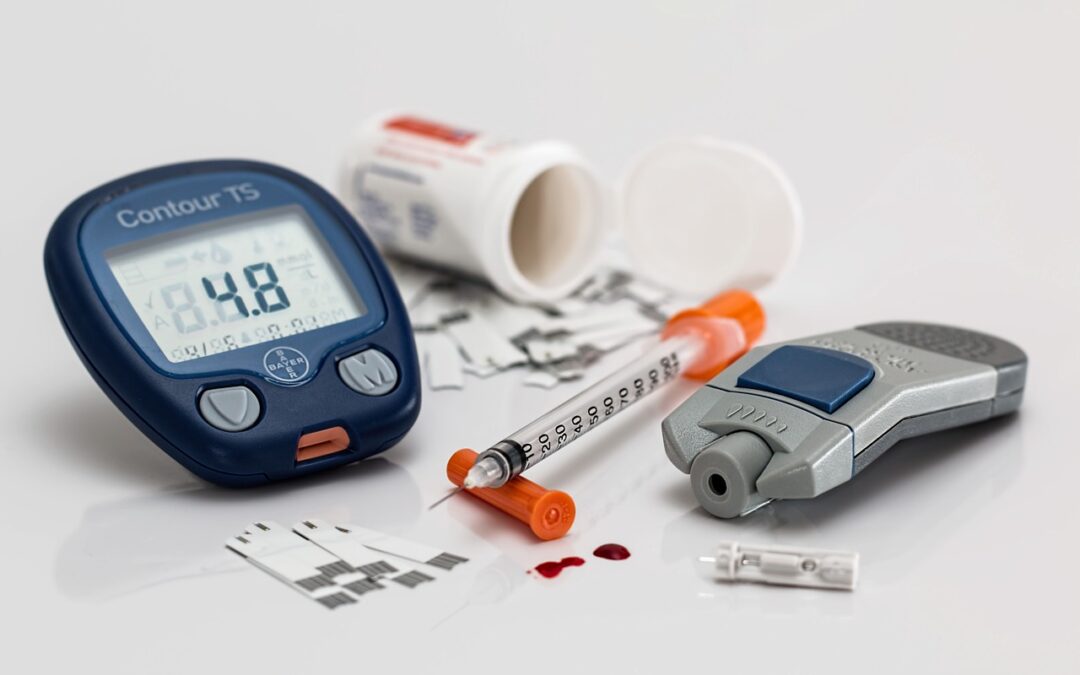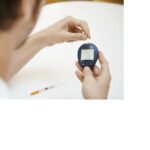
by I Dance With Diabetes | Aug 23, 2022 | Glucose
What is Diabetic Ketoacidosis
A severe and potentially life-threatening condition called Diabetic Ketoacidosis or “DKA” is a consequence of diabetes. Unhealthy levels of acidic ketones can build up in the blood when a person has inadequate amounts of insulin in their body. This is a condition you can monitor for and arrest long before the condition becomes a problem. You just need to know what to look for. This article will help guide you to recognize the DKA condition.
Diabetic ketoacidosis, or DKA, is a serious condition that can occur in those with diabetes. DKA happens when the body starts to break down fat for energy because it doesn’t have enough sugar. This makes acids called ketones, and too many ketones can make people very sick. They may develop a diabetic coma or, in extreme cases, die. DKA is more common among people with Type 1 diabetes, but anyone with Type 2 diabetes can also develop complications from it.
DKA happens when there is an accumulation of ketones in the blood. As glucose circulates through your body, your cells use insulin to let glucose into the cells. Normally, cells use glucose as their main source of nourishment. If you have diabetes your cells do not absorb or use blood sugars, because the body does not make enough insulin or the cells don’t respond to it.
The symptoms
The symptoms of ketoacidosis can change depending on the severity of the condition. The first symptoms, which can come on within 24 hours, include a strong desire for water and frequent need to use the bathroom, very elevated levels of glucose, and elevated ketone in the patient’s urine. If not treated, other diabetic conditions can quickly appear. These additional diabetes symptoms can include nausea and vomiting, abdominal pain, shortness of breath, fruity-smelling breath, and confusion.
If you experience any of these symptoms, it is important to seek medical attention immediately. DKA, or diabetic ketoacidosis, most often occurs in people living with Type 1 diabetes. In rarer cases, people who have Type 2 diabetes can get DKA if they are in stressful situations, are sick, or taking medications that are known to increase the chances of getting DKA. If you experience any of these symptoms, you should immediately call your physician, go to the nearest emergency room, or dial 911.
DKA occurs when the body does not have enough insulin to properly process glucose. Instead, it breaks down fat to fuel your cells. This reaction happens in the liver and creates acidic ketones. As ketones accumulate in the blood, DKA becomes the result.
The most common reason for DKA are:
Being sick – If you have an illness that causes you to lose your appetite, you don’t eat and drink as much as normal, and it becomes more difficult for your body to maintain glucose levels if you have diabetes. Diabetes makes it difficult for the body to regulate blood sugar levels, so if you’re not eating or drinking as much, it can make things even harder.
Issues with insulin management – Not taking insulin shots as prescribed, taking the incorrect dosage of insulin, having a malfunction with the insulin pump, or using expired or tainted insulin potentially lead to DKA.

Other conditions that can cause DKA are:
- Unexpected health conditions like stroke, heart attack, UTI (urinary tract infections), or pneumonia
- Exploiting drugs and/or alcohol
- Injuries to the body
- Any of the following medications corticosteroids, diuretics, dexamethasone, prednisone, or glucocorticoids
- Not realizing the initial signs of type 1 diabetes, when the liver begins to break down fat energy to the cells
- Being careless when taking diabetic medications
People with type 2 diabetes can also have DKA, although much rarer than those with type 1 diabetes. The conditions are similar to the list above. Other conditions may include; surgery, pregnancy, pancreatitis, steroids or antipsychotic drugs, developing blood clots in your lungs, or stomach sickness and extreme vomiting.
Testing
There are several tests available to determine your ketone levels, some of which can be done at home. Others may require a visit to a health care provider. Ketone testing is important for people with diabetes, as it can help them manage their condition and avoid serious complications.
Testing for ketones can be measured either through blood or urine test kits. A blood test measures the levels of beta-hydroxybutyrate. Some glucose meters can measure glucose and ketones. Check the manufacturer’s instructions for details. Tests for urine are done with strips that turn color to indicate the ketone levels.
Check with your doctor for information on a preferred method to test for ketones. If you have a high blood sugar reading, something over 240 mg/dL, or if you’re sick, you should check your ketone levels every four to six hours a day.
It can’t be repeated enough, if you have moderate/high levels of ketone contact your doctor. If unable to reach your doctor dial 911 for help or get to the emergency room if you find the above conditions DKA symptoms along with increased glucose levels.
If not treated it can be deadly
DKA can be fatal if left untreated, and it requires hospitalization for emergency medical treatment to prevent a diabetic coma or death.
If test results confirm a DKA condition, the first step is to lower glucose or blood sugar levels. When in emergency conditions DKA treatments normally include administering intravenous fluids to prevent dehydration, administering insulin to bring down blood sugar levels, and closely monitoring the patient in a hospital setting.
You should always consult with your physician or another medical provider if you feel that your diabetes is not under control. By doing this, you can ensure that you are receiving the best possible care and treatment for your condition.

As much as DKA is a serious and possibly deadly condition, you can easily avoid the condition by correctly managing your glucose/blood sugar levels. If you’re sick check your glucose levels every for to six hours. If prescribe diabetic meditations take it as directed, don’t skip taking it at the correct time and dosage. As your lifestyle changes follow up with your doctor to adjust insulin and medications to meet your situation.
Final thoughts
You can lead a good healthy lifestyle if you follow the instructions from your doctor on dealing with your diabetes. What is diabetic ketoacidosis, is a question you should be asking. Remember DKA occurs when you get sloppy with your meditations if you push into extreme conditions (sickness, changes in physical activity). If your lifestyle conditions change don’t be afraid to ask your doctor or a medical professional. It could save you an experience with ketoacidosis, DKA.
Please join our Facebook group and check out our other blog articles.
Read more: Drugwatch

by I Dance With Diabetes | Aug 23, 2022 | Glucose
Glucose: what are people asking?
You may have heard of glucose. It’s a pretty good chance you’ve heard about glucose if you’re a prediabetic or someone with diabetes. In this article, we’ll look into what glucose is and why is it important to understand its impact on your body.
Let’s start with what is glucose. Is it the same as blood sugar? The answer is yes, they are one of the same. Let’s take a closer look at where glucose comes from.
A lot of glucose comes from foods with high levels of carbohydrates, like bread, potatoes, and fruit. Food passes down your stomach as you eat. Food is broken down into small pieces by the acids and enzymatic there. In the process of digestion, glucose is released from the complex carbohydrates in the food. The food you eat doesn’t just go into your stomach and then ends up in your bloodstream. It actually has to be broken down in your gut first, and then it enters your bloodstream. Once it’s in your blood, it will trigger the release of insulin, which helps to lower the amount of sugar in your blood cells.
Wait a minute we just mentioned insulin, where did that come from? The beta cells in your pancreas are responsible for monitoring your blood sugar levels and keeping them constant. These cells check your blood sugar levels every few seconds and release insulin into your bloodstream when it detects that your blood sugar levels are high.
When you eat and your blood sugar rises, the beta cells in your bloodstream start to produce insulin. It’s important that glucose can enter the muscle, fat, and liver cells because of the magic of the key of Insulin. Your body can use the sugar it needs for energy through this process.
It’s a balancing act
Okay so it’s a balancing act of monitoring your glucose and releasing insulin to tell cells it’s time to eat, time let the glucose in. Diabetes then is when the dance of insulin and glucose isn’t dancing together correctly. Type 1 diabetes is when your pancreas isn’t able to release enough insulin or doesn’t release any insulin. You’ll need to inject insulin to help maintain glucose at the correct levels in your blood.
Type 2 diabetes is a little different situation. For some reason, which isn’t quite clear, your pancreas is having trouble managing the glucose levels in your blood. It released what it thought was the correct amount of insulin, but the cell didn’t get the message and isn’t reacting by taking in the glucose. The pancreas sees the glucose levels still being too high and releases more insulin. This process is known as insulin resistance or intolerance.
The problem with insulin resistance is glucose levels stay high. First, the pancreas may be working overtime to produce enough insulin to manage the glucose levels. You could damage the cell of the pancreas that produce insulin

Having constant high levels of glucose will create inflammation in the body, especially in the blood vessels. We don’t fully understand the cycle of inflammation caused by the high glucose level we can see its effect on your body. The inflammation will affect your heart, kidneys, eyes, and nerves. Your body will recognize the inflammation and create symptoms to address the inflammation. You may notice increased thirst. Your body wants to flush out the excess glucose. Of course, that means you will be peeing more.
Another reaction to the high glucose levels is the blood vessels thickening up. This is a problem in getting nutrients to the body’s cells. Especially in the capillaries of the kidneys and eyes. Breaks and leaks damage areas around the break or leak. Nerves are affected, this is why people will diabetes need to pay attention to unnoticed sores. Because blood isn’t getting into this area to provide nutrients and carry away waste products from the cell you begin the create an environment that kills off the cells.
If you are a diabetic monitor your glucose levels. live a healthy lifestyle, and lose weight. Watch the number of carbs you eat. Changing your lifestyle will go a long way to giving you a chance to live a pretty normal lifestyle. Let’s face it, almost everyone eats too many processed foods, We eat without knowing what we eat will do to our body. We would rather sit and watch T.V., and play on our phones. Give off the couch and take a walk, be active.
Keep track
It’s always a good idea to keep track of your health and get regular checkups. This way, you can be sure to catch any early signs of inflammation and take steps to control it. If you do have inflammation, working with a medical professional can help you find the best solution for reducing or managing it.
Here are some things to consider if you’re looking to improve your health, either by preventing future health issues or managing existing ones:

Making small changes in your lifestyle can have a big impact on your overall health. Whether you’re trying to eat healthier, get more exercise, or just reduce stress, these tips can help you on your way:
- Fight inflammation by eating anti-inflammatory foods. Take a look at fruits, vegetables, and foods rich in the anti-oxidants that come from cherries, berries, and other colorful fruits.
- Salmon is a good example of a food that you need to eat that is rich in omega 3s. Pick a good-quality supplement that’s undergone third-party testing. Both options can reduce pain related to inflammation.
- You can manage your stress levels by identifying their source. It’s crucial to develop strategies to cope with stress and inflammation, such as meditation and breathing techniques.
- Try to limit your intake of refined carbohydrates, sugars, and processed foods.
- Reducing tobacco use and avoiding alcohol might benefit from inflammation, so think about these alternatives as well.
- A great way to prevent many problems is by participating in physical activity. Acute exercise can cause inflammation for a short period of time. Regular exercise helps keep inflammation at bay for a long period of time. Moderate aerobic and weight-bearing exercises can be done three to five times a week. It’s possible that a protective effect on inflammation can be achieved by lean muscle mass.
Coming to the end
Glucose: What are people asking? Diabetes is a complex condition. You must monitor your glucose or blood sugar levels and get them at normal levels. It is a bit of a pain, but not managing your levels will bring greater problems. It’s your choice, what will you do?
Please join our Facebook group and check out our other blog articles.
Read more: WebMD

by I Dance With Diabetes | Aug 23, 2022 | Glucose
Glucose: Part 2
There are lots of questions about glucose. How do I test for glucose? What should I eat to have lower glucose? What are gestational diabetes glucose levels? Best time to measure glucose levels? And many more questions are being asked. In this article, we’ll address the questions about ways to monitor your glucose levels. If you have other questions, leave us your question(s) and we’ll research them for you.
How do I test for glucose?
There are many methods to test for blood glucose. The gold standard for measuring it is doing a finger prick to draw out a drop of blood. You then place some of the blood on a test strip. The test strip is then connected to a glucose monitor device and the device displays you’re blood sugar reading.
The history of testing blood sugar is an interesting study of ingenious problem-solving. Records showed that the Egyptians recognize people when suffering from diabetes as early as 1500 BC. They notice that ants were attracted to the urine of people displaying diabetic symptoms. The sugar (glucose) was sensed by the ants.
It wasn’t until the middle ages that doctors began to diagnose diabetes. The method to measure if someone had diabetes was to taste the person’s urine. I have heard that other cultures have done similar things to diagnose illness, but tasting urine, for me at least, would be a show stopper.
We have a diagnosis
Karl Tommer is recognized as the first doctor to clinically examine patients for diabetes in the early 1840s. By using the process of acid hydrolysis to break up disaccharides into monosaccharides. Then adding further chemicals, it would react in a way indicating sugar was present in the urine.
In the early 1850s, Hermann von Fehling was able to expand on the work of Trommer. This early technology was a key step in further defining the level of sugar in the urine. Later in the 19th century, Frederick Pavy created tablets that would detect high levels of sugar in the urine, Further work by Stanley Benedict refined Fehling’s testing process. In 1913 Ivar developed a method of testing blood for glucose.
During World War II, urine test strips were produced that would measure the amount of sugar in the urine. The results would be displayed in a shade of color. By comparing the color to a chart one would have the amount of glucose in the urine. The availability of these test strips was a major breakthrough in the medical field, as they allowed doctors to quickly and easily test for diabetes.

Enter technology
This simple and effective testing method became widely used, helping to improve the diagnosis and treatment of this serious condition. With the modern advances in technology, test strips were introduced in 1964 that could check the blood for sugar. This was a major breakthrough as it allowed people to monitor their own blood sugar levels. The first glucometer was created in 1970. People could now test their blood for elevated glucose levels. Then, in the mid-1970s, another test for diabetes was developed and it tested for hemoglobin A1c.
Today, the glucose meter is a simple way for people easily monitor their glucose (blood sugar) levels. Yet, using a glucose meter still requires you to prick a finger or some other area of your body. However, technology isn’t standing still. The advancement of glucose testing has now progressed to a sensor that can measure blood sugar through the skin, without having to take a drop of blood. This is significant progress as it is less invasive and more comfortable for patients. In addition, this new method is more accurate and provides real-time results. This device is known as a CGM (Continuous Glucose Monitor).
Can Star Trek be far behind?
In recent years CGMs have become a go-to solution for monitoring glucose levels. As the name implies, the monitor continuously checks for glucose levels, in reality, it checks every five minutes. A CGM device is attached to the underside of your arm or abdomen. It has a very small needle that will connect with the interstitial fluid and allow the device to sense your glucose levels. The information gathered is then sent to a wireless device, Andriod or Apple phones.
Other devices are being developed the test glucose levels in sweat, salvia, and tears. Current technology is being developed to check glucose levels in a person’s breath. Can the days of a Star Trek tricorder be far behind?
The advantage of CGM is the ease of use. First, you minimize or remove the need for finger pricking. Once the device is attached and set up you are freer to joy life. Depending on the manufactures design of the CGM, you can wear the device for 7 to 90 days. A patch covers the area of the device and allows you to shower and be active.
CGMs will give you a more accurate description of your glucose levels. The data can show you how you react to eating. Understanding how you react to food can help you eat properly. You can set alarms to let you know if your glucose levels are too high or too low. This knowledge will let you react quickly to changing needs. Thereby keeping you safer.
One caution to keep in mind is the CGM device is not a quick fix. It will take some time to learn about it and how to live with it. You have to weigh the advantages and disadvantages. Just like anything to do with diabetes, there is an effort you will have to put forward. The decision to with you.

Where is the future?
Diabetes has most likely been with us since humans first started walking upright. As we saw earlier the Egyptians are credited with recognizing ailing patients with diabetes. As time moved on we learned more about diabetes to the point we could begin to give a name to the diagnosis. Science and technology are giving us new and better ways to deal with diabetes. Yet the one area we are not very willing to change is what we eat.
We continue to produce food products that push our body’s limits to handle sugar. We need to address our eating situation if we truly want to get a handle on diabetes and live a healthier lifestyle. Glucose: Part 2 is the second of two articles on Glucose. We will continue to explore glucose impact on the body and report our findings to you.
Please join our Facebook group and check out our other blog articles.
Read more: Health Beat, Frontiers,















